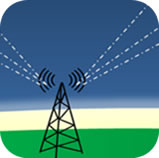
| {column0} |
| {column0} |
Many communication systems utilize the ionosphere to reflect radio signals over long distances.
 Ionospheric storms can affect High Frequency (HF) radio communication at all latitudes. Some radio frequencies are absorbed and others are reflected, leading to rapidly fluctuating signals and unexpected propagation paths.
Ionospheric storms can affect High Frequency (HF) radio communication at all latitudes. Some radio frequencies are absorbed and others are reflected, leading to rapidly fluctuating signals and unexpected propagation paths.
TV and commercial radio stations are little affected by solar activity, but ground-to-air, ship-to-shore, Voice of America, Radio Free Europe, and amateur radio are frequently disrupted.
Radio operators using high frequencies rely upon solar and geomagnetic alerts to keep their communication circuits up and running.
Radiation storms, also known as solar particle events or proton events can affect the lower regions of the polar ionosphere. This region can become ionized and severe HF and VHF signal absorption may occur. This is called a polar cap absorption (PCA) event. PCA events may last for days or weeks and polar HF radio propagation often becomes impossible during these events.
All of this makes the D-Region Absorption Product (D-RAP) a particularly useful tool for radio communicators since D-RAP identifies BOTH regions that are experiencing signal degradation or radio blackout conditions due to effects from X-ray flares or Solar Energetic Particle (SEP) events. The other option is to look at each of these conditions separately through separate Flare Alerts and Solar Proton Alerts.